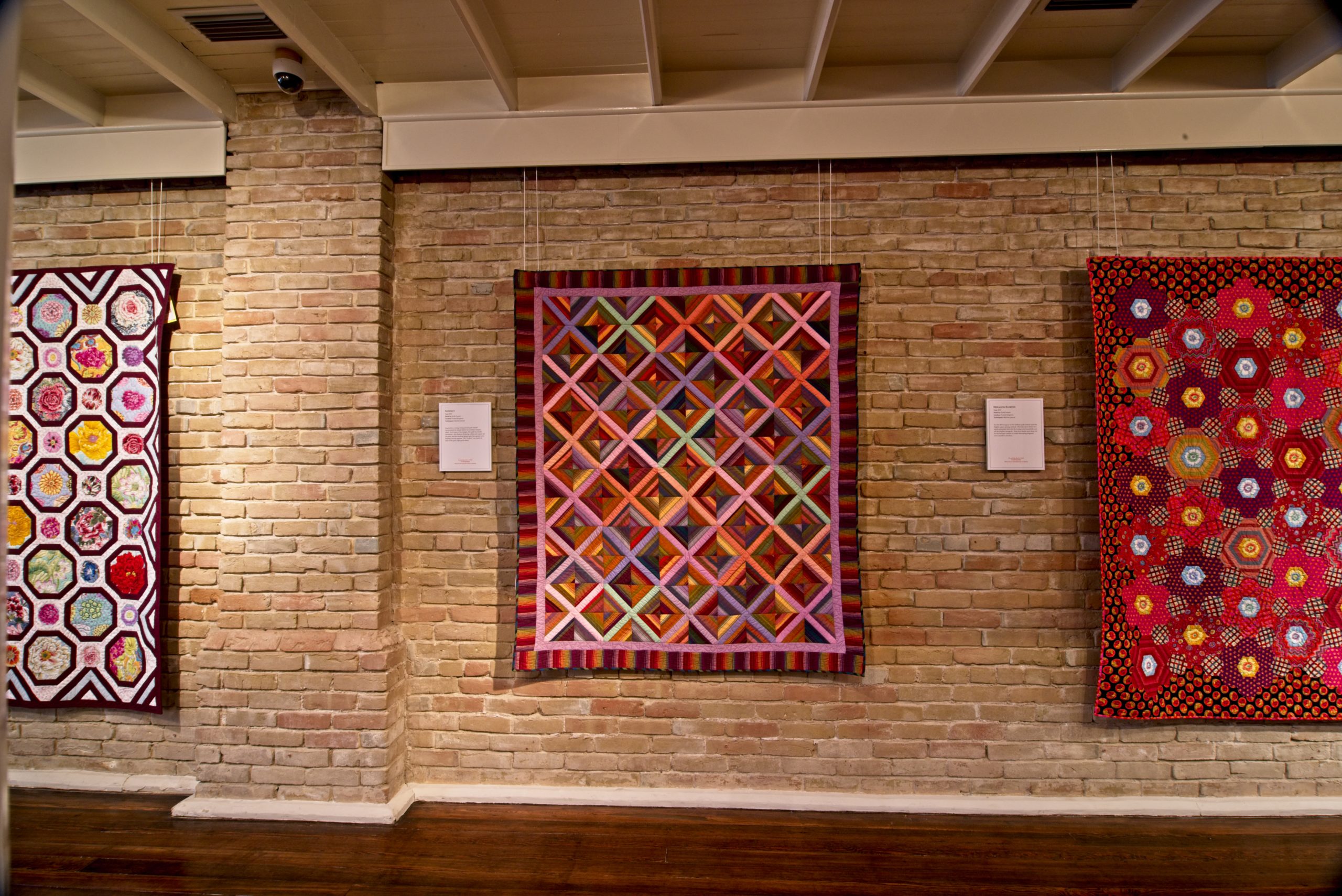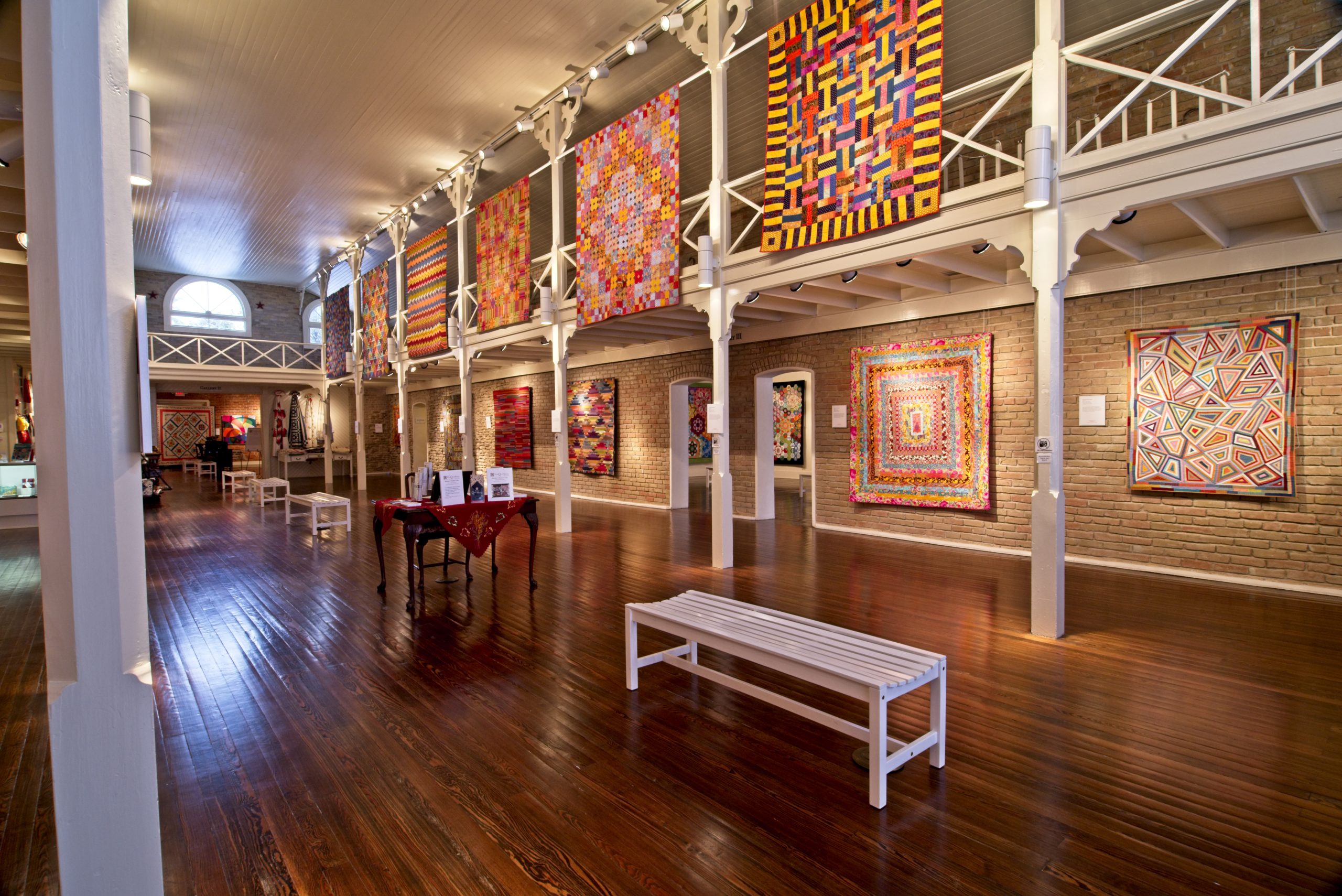The Texas Quilt Museum: Showcasing the Art of Quilting
The Texas Quilt Museum in downtown La Grange features traditional and contemporary quilt art from across the globe.

2025 Spring Antiques Show | March 20 – April 6
2025 Fall Antiques Show | October 4 – 18
The Texas Quilt Museum in downtown La Grange features traditional and contemporary quilt art from across the globe.

The Texas Quilt Museum in downtown La Grange features traditional and contemporary quilt art from across the globe.
The non-profit museum, which opened in 2011, is housed in two historic 1890s buildings with high ceilings, brick walls and original hardwood floors that provide a striking backdrop for textiles. Houston architect and historical preservation specialist Barry Moore also maintained many of the original railings, moldings and other architecturally significant features to further enhance the visual experience.

The museum was founded by fifth-generation Texas quilters and cousins Karey Bresenhan, CEO of Quilts, Inc., and Nancy Puentes, executive vice president of Quilts, Inc. The corporation produces the annual International Quilt Festival in Houston in addition to other quilt shows and quilt-related trade shows.
Since 1975, thousands of quilts passed through Texas as part of the annual International Quilt Festival. The experience was magnificent but fleeting. The duo dreamed of having a place where artfully crafted quilts could hang for longer periods of time—and the Texas Quilt Museum was born.
Museum staff members curate a new exhibit every three months using the three available galleries. Generally, the exhibits include a mix of traditional, contemporary, art and antique quilts, so the full-range of expression is on display at any given time in the 10,000 square foot space.
Art graces the museum’s exterior as well. A bold mural on the west side of the taller structure—the 1893 Reichert and Kneip Furniture Store—boasts a finely detailed image of colorful quilts draped over a clothesline. The mural is complemented by “Grandmother’s Flower Garden,” a period garden patterned after a typical 1890s city garden in Fayette County and named after a beloved Depression-era quilt pattern.
The Texas Quilt Museum, which is open Thursday – Sunday year-round, attracts quilt enthusiasts from around the world.
Join us for a look inside the museum—and the art of quilting.
A Quick Q&A about Quilts

At the time of this writing, Texas Quilt Museum founders Karey Bresenhan and Nancy Puentes were in the throes of hosting the International Quilt Festival, which includes exhibits, classes and a trade show spread over a week. It fills the George R. Brown Center and attracts thousands of people from around the world. Despite her schedule, Nancy and I “pieced together” an e-mail interview about all things quilt.
RTTLS: Why was La Grange chosen as the home for the quilt museum?
NP: We’re often asked why we chose La Grange as the home of the Texas Quilt museum, but it makes perfect sense. La Grange is just about the same distance from three of Texas’. . . and the United States’. . .largest cities: Houston, Austin and San Antonio, a little over an hour’s drive on good highways. . . and it’s not too far from Dallas and Fort Worth.
But the high quality of museum’s exhibits, and its growing recognition as one of the very best places to see fine antique and contemporary quilt art, mean it is drawing visitors not only from across the country but also internationally. As a matter of fact, visitors from 58 countries have visited the Museum since its opening in 2011.
RTTLS: Historically, what roles did quilts play in American homes?
NP: Quilts were a vital necessity from the time of the earliest settlements in the U.S. Colonists brought quilts and quilting techniques with them, and the need to recycle worn textiles into usable warm bedding ensured that quilting would continue in America. Textiles were especially valuable because there was no textile industry in the colonies.
RTTLS: When did quilts transition from a “practical handcraft” to a fine art form?
NP: Quilters have always made “special” quilts, even though only recently has the term “art” been applied to them. Those quilts might have been made for a young woman’s hope chest, for a visiting minister or as a gift to a beloved family member or friend. A woman’s special quilts displayed not only her creativity in selecting a design, colors and fabrics but also her quiltmaking technique.
Of course, there were always a few individuals who “broke the rules” and came up with a completely new theme for a quilt. Many of those became cherished folk art quilts passed down for generations.
RTTLS: How has technology (e.g., sewing machines, computers, etc.) transformed quilting as an art form and as a social activity?
NP: Technology is not new in quiltmaking. The American sewing machine was invented in 1846 and quickly spread throughout the country as a prized timesaver.
Now sewing machines are computerized, and large quilting machines are available to speed up the quilting

process. Some quiltmakers design their quilts on the computer or use the computer to tap into design ideas. One thing today’s quiltmakers have is the ability to network 24/7 with other creative and like-minded individuals.
But however much technology has changed quiltmaking for some, there are still quilters who love the process of working by hand on every aspect of their quilts. Some describe quilting by hand as akin to meditation.
RTTLS: What qualifies a piece as an art quilt or a work of fiber art? How does that differ from traditional patterned quilt?
NP: Art quilt? Fiber art? Traditional quilt? As in a painting, art is in the eye of the beholder when it comes to quilts. Some think abstract, geometric or folk-themed quilts are unique to today’s quilter, but all have been made by quilters for generations.
RTTLS: In your opinion, what is it about the art of quilting that inspires so many different expressions of creativity?
NP: Making a quilt has the same scope for creativity as making a painting. . . it’s just that the materials used are different. Where a painter uses canvas, brushes and paint, the quilter uses needle, thread and fabric. Therefore, both painter and quilter are free to express whatever they want, providing each with unlimited potential for creativity.

As part of its offerings, the Texas Quilt Museum regularly offers lectures. In late October, the guest speaker was London-based Kaffe Fassett, an internationally recognized textile designer who created knitware for Italy’s Missoni family before launching his own line that now includes patchwork as well as knitware and needlepoint. One expert estimated Fassett, the author of 30 books, is responsible for designing about 50 percent of fabrics used in today’s quilts. A series of his quilts taken from his latest book featuring his fabrics were on display in the main gallery.
I break a panicked sweat when I attempt to thread a needle, so I stuck out like a hand-quilter’s thumb sans a thimble at Kaffe Fassett’s (rhymes with Safe Asset) lecture. The woman to my right, now a grandmother, had been sewing since she four years old. She was the rule. I was the exception.
The excitement was palpable. The predominantly female crowd was twittering like my big-haired friends and I used to do before big-haired metal bands took the stage in the 80s.
“You know, he’s the rock star of the quilting world,” my seatmate said as way of explanation.
It was a sold-out crowd. As a writer, I was a last-minute guest. I stood to offer my back-row seat to someone I thought was a latecomer. I had failed to recognize museum co-founders Karey Bresenhan and Nancy Puentes, who had been detained in Houston traffic making their way from the International Quilt Festival to La Grange. Along with the founders, I was ushered to a front-row seat that had been reserved for me.
“I think you’re going to enjoy him,” Puentes said.
Understatement of the night.
In addition to having, as Bresenhan described, “an eye for color that is breathtaking,” Fassett wove a story of his
life, career and inspiration that was equal parts humorous observation and telling detail. The accompanying slide show provided peeks of personal history, career defining fabrics and inspiration.
Fassett, who was reared in northern California near Big Sur when “there were 300 people spread over 72 miles,” relocated to England in 1964.
“England was a good finishing school,” Fassett said. “There was a wonderful patina—everything was shredded with age and history—and people just lived with abandon surrounded by it all.”
In England he journeyed to Scotland with a young designer to assist with a collection of Tartans. Fassett was smitten by the hues of the landscape that were replicated in the yarn in the mills. Inspired by the palette, he cajoled a stranger on a train into teaching him to knit. The lesson lasted 20 minutes. He knitted a waistcoat using all 20 colors of yarn he had available in it—and then delivered it to British Vogue.
The editors opined he’d one day design for Missoni. They published the waistcoat. The Missoni family called

wanting to see his collection.
“I invited them to my showroom—my tiny flat, and I showed them my collection—a single sweater,” Fassett said.
The one-piece collection earned him the job of a Missoni designer, which served as a launch pad for his career, which now includes an international design empire.
“People often ask where I get my ideas from,” Fassett said, bringing a photo of a potted palm on the screen and laughing. “By going to a drunken lunch with a friend and spotting a fabulous palm in a fabulous planter and then going home and painting it.”
Chinese porcelain, aboriginal paintings, Moroccan mosaics, and nature’s forms all serve as inspiration.
“My first fabric design involved a giant purple kale,” Fassett said. “It scared the hell out of the Thimbleberries [a fabric company with traditional patterns] people.”
While he continues to create prolifically, Fassett also finds satisfaction in seeing his work provide the foundation for others’ creativity.
“It is really good to see when talented artists make your raw fabrics sing,” Fassett said.
Despite decades of success, the designer still appreciates a well-designed exhibit of his work such as the one at the Texas Quilt Museum.
“I tend to keep my work stored in a dusty garret,” he said. “To have it brought out, beautifully lit and hung with respect is a wonderful treat and honor for an artist.”
——————————————————————————————————————–
Photos by Rachel Alfonso-Smith, Shutterbunny Photography
2025 Spring Antiques Show | March 20 – April 6
2025 Fall Antiques Show | October 4 – 18